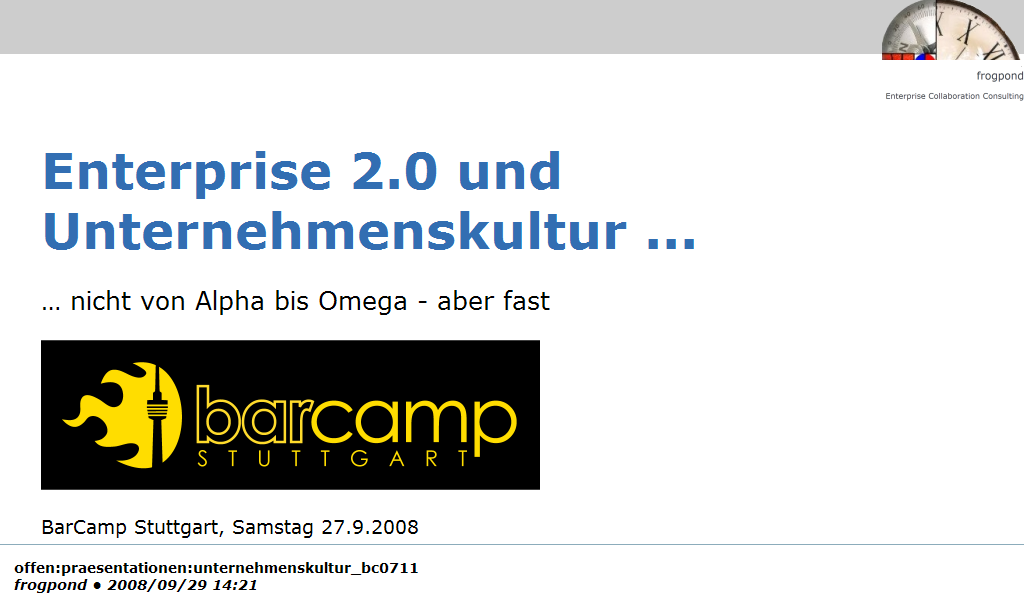Es wird Zeit für meine Rückschau auf das Barcamp Stuttgart Wochenende. Kurz gesagt – es war so gut, dass eine Neuauflage im Herbst/Winter 2009 geplant ist. Hier kann man sein Interesse bekunden: BarcampStuttgart2, mehr Informationen folgen dann.
Eine zentrale Frage ist es natürlich wie dann das Event-Tag aussehen soll, das diesjährige Tag #bc0711 müssten wir wohl ergänzen. Aber #bc0711_2 – nun ja, ich weiß nicht …
Viele Sessions habe ich selbst dieses Mal nicht besucht, entsprechend ist die Anzahl und der Umfang meiner Berichte beschränkt. Aber Kaffeemachen bzw. die Diskussionen mit vielen alten und neuen Bekannten (u.a. Christian Spannagel) gehen nun einmal vor. Insofern verweise ich hier mehr auf die Vielzahl der Berichte anderer, aber auch auf die vielen Tweets und Dents.
Die Unterlagen meiner eigenen Session zum Thema Enterprise 2.0 und Unternehmenskultur reiche ich hier nach. Nicht in Form von Slideshare oder Powerpoint sondern als Präsentation im Wiki (Bild ist verlinkt …):

Ausgehend von zwei Konzepten (Implementierung, Enterprise 2.0) kam ich zum Faktor Unternehmenskultur (und dem Faktor Mensch). Der Claim “… nicht von Alpha bis Omega – aber fast” ist dabei natürlich unrealistisch – hinter allen drei Begriffen tun sich Welten auf, die zudem massiv zusammenhängen.
Letztlich wurde die Session denn auch zu einem Par-Force-Ritt durch verschiedene Modelle und Konzepte des organisatorischen Change Managements, u.a. Zielgruppen des Wandels, Gewinner und Verlierer, Stakeholder-Analyse, Ansatzpunkte der Implementierung, Infrastruktursektoren, Erfolgsfaktoren und mehr bevor ich am Ende auf ein paar Theorieklassiker der Organisationswissenschaften (Edgar Schein und Co.) eingehen konnte.
Mir hat die Diskussion viel Freude gemacht, das erste Ziel das diffuse Konzept “Unternehmenskultur” für die Teilnehmer etwas konkreter und handhabbarer zu machen habe ich sicherlich zum Teil erreicht. Bspw. weil es dazu führte dass sich der eine oder andere damit mehr beschäftigen will. Verständnis für die Ebenen, Funktionen und “Mechanismen” der Unternehmenskultur ist eben extrem wichtig für die Einführung von Enterprise 2.0 ist. Ja, fast schon ein Mantra: “Changing tools without a real cultural and process change won’t do it”.
Zuletzt – ohne die Finanz- und Sachsponsoren ist es nicht möglich ein Event dieser Güte zu organisieren. Allen Sponsoren sei hiermit ein riesiges Lob gezollt, das Engagement wurde von allen registriert und beachtet. Auch die Organisation durch das (Kern-)Orga-Team Jan, Markus und Carsten ist bemerkenswert. Ich selbst war als Wiki-Kümmerer wie andere mehr am Rand involviert, umso mehr kann ich einschätzen wieviel Zeit und Mühe die drei investierten. Ein großes Dankeschön – ich freue mich schon auf die Orgarunden zum BarCampStuttgart2.



